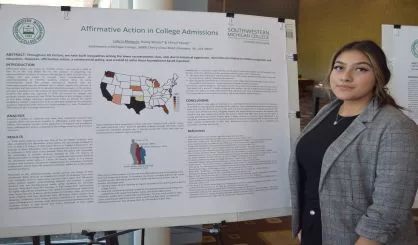Southwestern Michigan College Honors Program’s four “NoTED Talks,” plus poster presentations April 21 in the Student Activity Center, delved into a smorgasbord of topical issues.
Research ranged from aerial orthomosaics to the psychology of the Jan. 6, 2021, insurrection, climate change, food waste, criminal profiling and using motor oil to detect engine malfunctions.
Befitting a student speaker for April 30’s School of Arts and Sciences graduation, Dowagiac’s Leticia Marquez did one of each, applying calculus to cardiac output. She had just learned her research on Affirmative Action in College Admissions was accepted for presentation to the American Sociological Association in Los Angeles in August.
The president of SMC’s Phi Theta Kappa honor society will attend the University of Michigan (U of M) on a full-ride scholarship to eventually become a pediatrician.
Construction Trades was represented for the first time by Nickolai Emde, who deconstructed three projects — a cutting board, a chessboard and a banana holder (“I really like bananas”). He worked with white oak and walnut, obtaining rough-sawn lumber from a Dowagiac sawmill, then planing, sanding (“my favorite process, even though it’s tedious”), seamlessly gluing four pieces and staining to highlight wood grain.
Though she sounds like a criminal-justice major with “BAU,” the 1972 Behavioral Analysis Unit department of the Federal Bureau of Investigation’s National Center for the Analysis of Violent Crime, Aliya Platt of Plainwell studies business management.
“I’m in construction, actually,” she said, “because I want to flip houses. I almost went to Ferris State University for construction management. Here, I can put business and construction together in entrepreneurship.”
Benjamin Miller is an Edwardsburg High School student studying Calculus III.
“Aerial orthomosaics is the process of capturing thousands of photos and using computer software to stitch them into one single photo,” Miller said. “Data can be used to create elevation profiles and contour lines to predict flow of water as well as plant health based on color.
“Capturing these images is done with software which utilizes vectors to define predetermined flight paths for the drone to follow. The software also determines capture angles. I’m able to produce three types of maps from these images.”
“I bought a drone from my summer job mowing” a Berrien County property plagued by flooding, said Miller, studying aerospace engineering at U of M this fall.
Noah Taulbee from Edwardsburg High School is transferring to Western Michigan University for mechanical engineering. He analyzed his own 2006 3.3L Toyota Highlander Hybrid with a V6 engine and almost 200,000 miles. “There was an excess of aluminum in the motor oil which could indicate excessive engine wear,” Taulbee found.
Hailie Lucas presented two projects, explaining the Jan. 6 insurrection with social psychology concepts and charting her exercise’s relation to relieving stress for six weeks, including running, weightlifting, yoga, stretching and walking.
“The whole goal of this project is to explain what they were thinking in the moment,” Lucas said. “I was shocked and scared when (the storming of the Capitol) happened. I never thought anything like this would happen, but it could happen again if we don’t see the signs and make it stop before it gets out of hand.”
Lucas grew up in Virginia, where her father served in the Navy, finished high school in Wisconsin and selected SMC to transfer to Michigan State University.
Kate Miles illustrated her climate-change poster with Glacier Bay National Park, Alaska.
“Any form of precipitation is uncommon. Precipitation means air is holding water, and those air particles have to be warm to carry that water. The air is way too cold to hold any water. For water to attach to air particles, they must come from somewhere — melting glaciers. This turns into a cycle of not snow compacting creating ice, but ice melting, creating water for snow in warm temperatures for even more melting to occur. It’s a vicious cycle and a very important one to understand when it comes to our planet’s changing climate,” said the Centreville environmental science major who will play volleyball for the Roadrunners this fall.
Tanner Orton of White Pigeon, 2021’s Constantine valedictorian, became interested in food waste working as a waiter for a Middlebury restaurant (though 37 percent occurs in households, compared to 21 percent on farms, 14 percent in manufacturing, 12 percent in grocery stores/retailers; and 10 percent in restaurants).
Orton, interested in cybersecurity and SMC’s transfer agreement with Ferris, identified multiple solutions: source reduction and reuse; donating to the one in eight Americans who go hungry; feeding scraps to animals; industrial uses (liquid fats can be rendered into cosmetic products and soap or converted into a form of biofuel); and composting. The United States ranks third behind China and India, with 30-40 percent of all food produced wasted.






